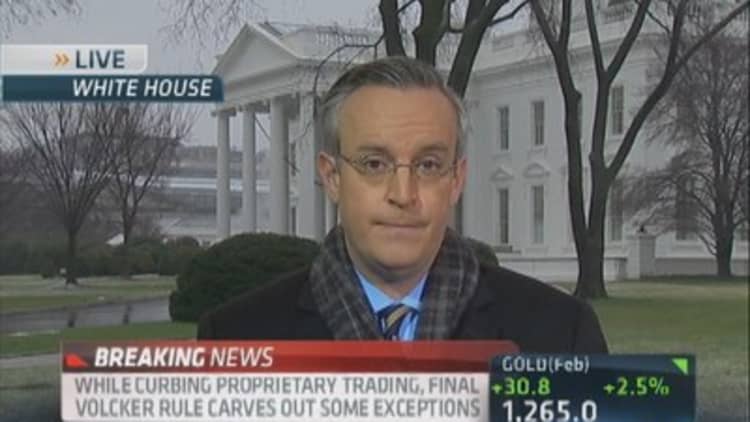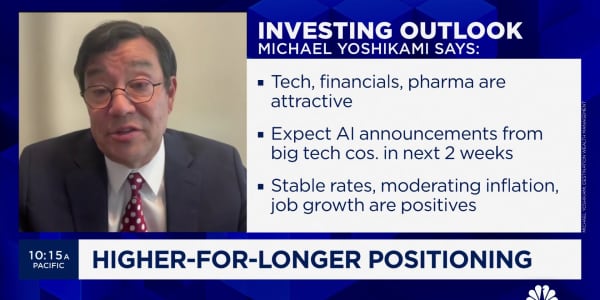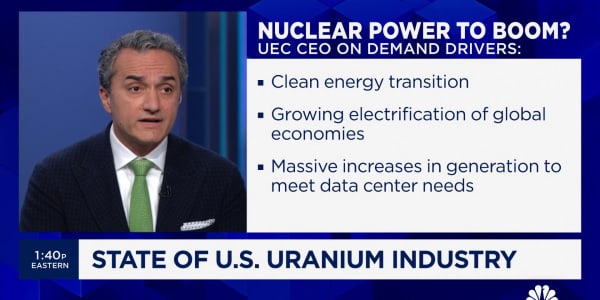At the heart of the Volcker Rule is the distinction between proprietary trading and trades aimed at market-making or hedging risk.
The success of the rules, the final draft of which were just released on Tuesday morning, will depend on how effectively regulators fenced off banned prop trading from permitted market making and hedging.
Five federal agencies approved the rule Tuesday—some 1,419 days after President Barack Obama announced that the rule would be included in the Dodd-Frank financial reforms.
The basic structure of the rule, outlined in 71 pages of regulation and more than 900 pages of commentary from regulators, reflects the simplicity of the idea and the complexity of its implementation.
The simple part: Banks are banned from engaging in prop trading. The complex part: That ban is subject to several exemptions intended to allow banks to facilitate customer trading and hedge their own risks.
Let's focus on two that are central to the business of Wall Street: market making and hedging. There are also very complex exemptions for "covered funds" (such as hedge funds, private equity funds and other investment funds) run by banks, but those will be covered separately.
Market making

The first set of exemptions revolves around market making, in which banks take positions in markets by purchasing, holding and selling financial instruments in anticipation of the needs of their customers.
(Read more: Cramer: Volcker Rule probably bullish for banks.)
There are some who believe that even market making is too risky for banks. Why can't banks just wait for customer orders before buying a security?
This would allegedly lead to less liquid markets, slower processing of customer trades, and poorer pricing. Your local grocery store, for example, doesn't buy, say, winter squash based on actual customer orders—it buys inventory in advance of customer demand so it can have squash on hand when a customer wants it. Wall Street firms want to do the same thing with bonds and other securities.
The great concern is over how to judge whether a bank is purchasing a security as part of a proprietary trading strategy or a market making strategy.
Both kinds of trades look very much alike. A bank uses its own capital to make the trades, which means it takes on risk from holding the position. In either case, it can profit when the market moves in one direction and lose money if it moves in the other.
In the rules released Tuesday, regulators sought to distinguish between the two types of trading through the lens of history and vague "market factors." Banks will be required to engage in analysis that shows trading is aimed at meeting "historical customer demand."
(Read more: What you need toknow about the Volcker Rule)
Trading will only be permitted if a "firm's trading desk's inventory in these types of financial instruments is designed not to exceed, on an ongoing basis, the reasonably expected near-term demands of customers," according to the official summary of the rules released Tuesday.
This means that there's no bright line for banks or regulators to follow. What counts as permitted trading will depend on the type of financial instrument, historical data, and market conditions.
That's a lot of room for judgment—or funny business—on the part of banks, regulators or both. But, mostly, it's what market-making desks were largely doing in the first place.
This may put a lot of pressure on another aspect of the rule—the limit on compensation. The Volcker Rule seeks to prohibit banks from paying traders for undertaking proprietary trading strategies by saying that compensation schemes should be risk-adjusted and focused on meeting customer demand rather than just a trading desk's profit and loss.
This may seem like a bigger change than it is.
(Read more: For BofA, billions more in legal costs from crisis)
The big Wall Street firms were already mostly paying market making desks on a risk adjusted basis. The rule is mostly codifying current practice. And it still depends, crucially, on a bank's ability to properly assess the risks its trading desks are taking on.
In other words, it appears that the Volcker Rule mostly succeeds when it comes to letting banks engage in market making.
Portfolio hedging: a whale of a problem

Another exemption required by law was for hedging.
Regulators agreed on allowing banks to take positions to offset the risks they take in making loans and market making. And since some individual positions are extremely difficult or costly to offset, regulators agreed that banks should be allowed to engage in trades meant to offset "aggregate" risks across many parts of the bank.
This hedging of aggregate risk is also known as a "portfolio hedge." Here the rule is haunted by the ghost of the London Whale, the $6.2 billion loss suffered by JPMorgan Chase on positions taken by a unit supposed engaged in hedging risk.
The dilemma faced by regulators was how to allow a bank to hedge risks across the entire bank without creating a backdoor for proprietary trading. The answer regulators came up with seems to be: Bury them in paperwork.
The final rule allows for portfolio hedging so long as it is "designed to reduce, and demonstrably reduces or significantly mitigates, specific, identifiable risks of individual or aggregated positions of the banking entity." Which presumably means you can't just take a massive position in, say, the credit-default swap market on the vague premise that as a huge lender you're massively exposed to credit defaults.
(Read more: Wall Street: The day of reckoning nears)
You also can't hedge against falling profits, broad market movements, or economic conditions. Instead, you have to point to a specific exposure and explain why this position is a hedge against that exposure.
The rules require to document each position, and engage in "analysis and independent testing designed to ensure that the positions, techniques, and strategies used for hedging are reasonably designed to reduce or otherwise mitigate the risk being hedged."
One thing the banks won on this issue is the ability to do "anticipatory hedging." That is, banks will be allowed to hedge against risks they haven't yet taken on but expect to. Critics will see this as a back door for prop trading. Expect some mild freaking out about this.
Wall Street already changed
Much of what's in the rule won't really require too much change on Wall Street—although not for the reasons the financial sector's fiercest critics may think. The truth is that the new rules mostly codify changes that the banks put in place after the financial crisis and in anticipation of stricter regulation.
A lot of the prop traders are already gone, off to hedge funds that sit outside the Volcker Rule.
(Read more: Volcker rule driving talent to hedge funds.)
Which isn't to say the Volcker provisions are useless or redundant.
Having the rules in place may prevent banks from engaging in the worst sorts of heedless risk taking. The requirements to specifically document why certain types of trading are market making or why they are hedging, and to follow up with analysis could make banks smarter. Requiring rules around the compensation of market-makers, likewise, should help banks resist letting those desks slowly slide into the business of proprietary trading.
A note of caution: No one really knows how these rules will operate under pressure.
They require the vigilance of both bank management and regulators.
There's a lot that depends on judgments about what is reasonable under the circumstances—precisely the kind of judgments that both financial executives and regulators failed at making the last time around.
The problem of just getting things wrong doesn't go away just because you're doing a lot of paper-shuffling.
—By CNBC's John Carney. Follow him on Twitter @Carney







